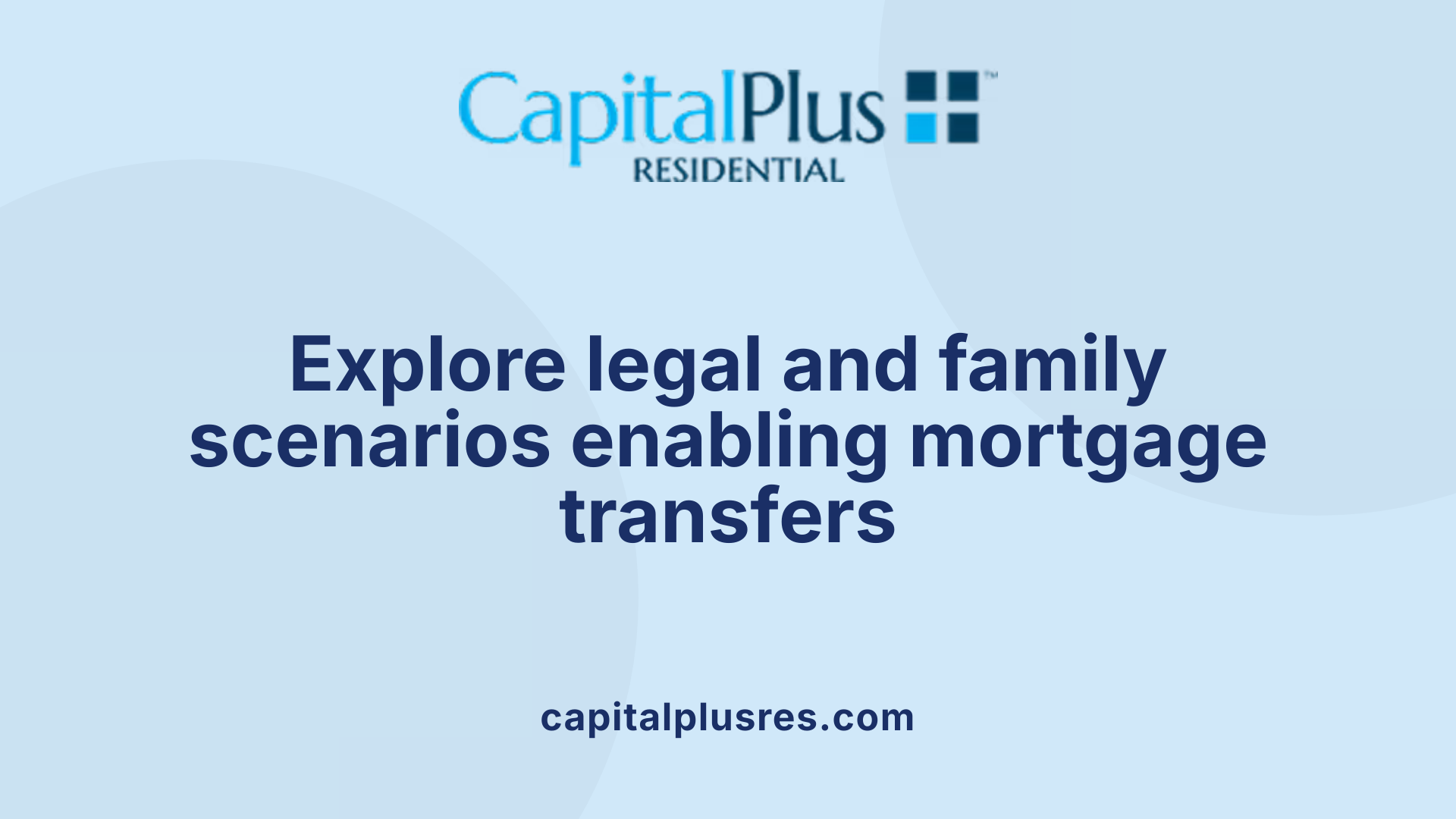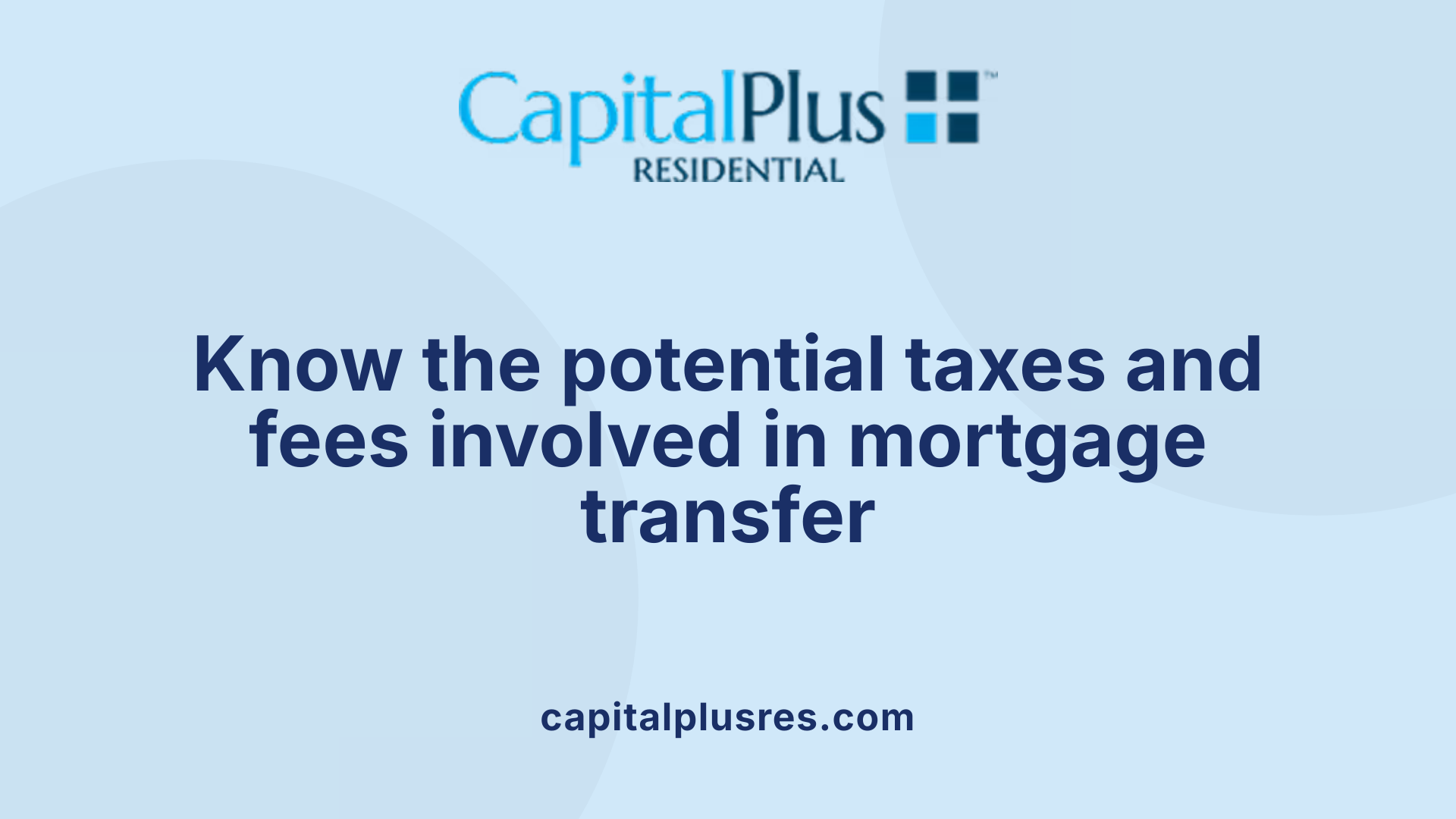Understanding Mortgage Transfers
Transferring a mortgage to another borrower involves reassigning an existing home loan so that the new borrower assumes responsibility for the remaining balance under the original loan terms. This process, often referred to as mortgage assumption, can provide benefits such as retaining favorable interest rates, avoiding foreclosure, and facilitating family property transfers. However, the feasibility of transferring a mortgage depends largely on the type of loan, lender approval, and legal restrictions.
What Is Mortgage Transfer and How Does It Work?

What does transferring a mortgage entail?
Transferring a mortgage means reassigning an existing mortgage from the current borrower to another person or entity. The new borrower agrees to continue making payments under the original loan terms, including the interest rate, remaining balance, and repayment period. This process is commonly known as mortgage assumption.
How does the mortgage transfer process work?
The transfer process begins with contacting the current lender to verify the loan's status and to obtain approval. The prospective borrower must then be assessed for creditworthiness through checks on income, credit score, and other financial factors. After qualification, the parties complete necessary paperwork, such as an assumption agreement, and pay any applicable transfer taxes or fees. Finally, the lender updates property records to reflect the new borrower's responsibility.
Roles of original and new borrower
The original borrower typically remains responsible for the loan payments until the transfer is officially approved. Upon successful transfer, the new borrower assumes full responsibility for the mortgage, while the original borrower may be released from obligations if the lender issues a release of liability.
Terms retention
One important aspect of mortgage transfer is that the original loan terms remain unchanged. The new borrower continues payments at the same interest rate, maintains the repayment schedule, and honors the remaining balance as per the original agreement. This benefit can make mortgage assumption an attractive option in certain situations, such as avoiding foreclosure or securing a favorable interest rate.
| Step | Description | Responsible Party |
|---|---|---|
| Contact Lender | Verify loan status and obtain transfer approval | Original Borrower |
| Assess Credit | Review new borrower’s creditworthiness and income | Lender |
| Complete Paperwork | Sign assumption agreement and transfer documents | Both Borrowers & Lender |
| Pay Fees/Taxes | Cover any transfer taxes or applicable fees | New Borrower |
| Update Records | Record transfer in property and loan servicing systems | Lender |
Assumable Mortgages: FHA, VA, and USDA Loans

Which types of mortgages are typically transferable?
Many government-backed mortgages, including FHA, VA, and USDA loans, are often assumable. This means they can be transferred from the original borrower to another person or entity without changing the original loan terms such as the interest rate, balance, or repayment period. Assumptions allow the new borrower to continue making payments under the existing agreement.
Government-backed loan benefits
Assumable loans typically offer advantages like avoiding the higher interest rates of new mortgages and reducing some closing costs. They can be particularly useful in situations where the original mortgage has favorable terms compared to current market rates. This benefit extends to FHA (Federal Housing Administration), VA (Department of Veterans Affairs), and USDA (U.S. Department of Agriculture) loans, which cater to different borrower groups but share the assumability feature.
Lender approvals required
Although many government-backed loans are assumable, the transfer isn't automatic. The borrower seeking to assume the mortgage must obtain lender approval. This often involves submitting an application, going through credit and income assessments, and sometimes paying transfer fees or applicable taxes. Lenders have discretion to approve or deny the transfer based on their policies and the borrower's financial qualifications.
In summary, FHA, VA, and USDA loans stand out as the primary types of mortgages that allow assumption, offering significant benefits with approval from lenders being a crucial step in the process.
Limitations and Restrictions: Conventional Mortgages and Due-on-Sale Clauses

Why Are Most Conventional Mortgages Not Transferable?
Most conventional mortgages are not transferable primarily because they include what's known as a 'due on sale' clause. This clause requires the full repayment of the mortgage when the property is sold or otherwise transferred. As a result, potential new borrowers cannot simply assume the mortgage under its original terms.
What Is a Due-on-Sale Clause?
A due-on-sale clause is a provision in many conventional mortgage agreements. It allows lenders to demand immediate repayment of the remaining loan balance if the property securing the mortgage changes ownership. The clause protects lenders from the risk of unknown or less creditworthy borrowers assuming the loan.
Are There Exceptions to Due-on-Sale Clause Enforcement?
Yes, certain exceptions limit enforcement of due-on-sale clauses. The 1982 Garn-St. Germain Act restricts lenders from invoking this clause under specific circumstances. Typical exceptions include:
- Transfers resulting from death of the borrower
- Divorce or legal separation transfers
- Transfer of property within a living trust where the borrower remains the beneficiary
These exceptions mean that in some cases, the mortgage can be transferred without triggering full repayment, but the process still typically requires lender approval and proper legal documentation.
Understanding these limitations is essential for homeowners considering transferring a conventional mortgage. Government-backed loans like FHA, VA, and USDA mortgages offer more flexibility due to their assumable nature, but conventional loans carry stricter restrictions.
Situations Warrenting Mortgage Transfers: Family Changes and Legal Circumstances

In what situations is transferring a mortgage possible despite general restrictions?
Transferring a mortgage, while generally restricted due to clauses like the 'due on sale' clause, is often permitted in specific family and legal situations. These exceptions typically include the death of a borrower, divorce or separation, transfers within a living trust, and instances of inheritance.
How do family changes affect mortgage transfers?
When a borrower passes away, lenders may allow the mortgage to be transferred to an heir or family member, especially if the mortgage is government-backed or assumable. Similarly, during divorce or separation, one party may assume responsibility for the mortgage, provided the lender approves and the new borrower qualifies.
What is the role of living trusts in mortgage transfers?
Transferring a mortgage within the context of a living trust is often possible with lender approval. This process involves legal documentation to update ownership while keeping the mortgage terms unchanged, facilitating estate planning and property succession.
What legal documentation is necessary for transfers?
Proper legal paperwork is crucial to complete a mortgage transfer. Typically, a quitclaim deed or similar document is filed to formally transfer property title. Additionally, lenders require documentation to verify the new borrower's eligibility and the legitimacy of the transfer.
These carefully regulated exceptions enable mortgage transfers under special family or legal circumstances, helping borrowers manage loans responsibly without triggering full repayment demands.
The Steps to Transfer a Mortgage to Another Borrower

What are the essential steps involved in transferring a mortgage?
Transferring a mortgage requires a clear process to ensure the new borrower takes over the loan under the original terms. Here’s how the process typically unfolds.
Contacting the Lender
The first step is for the current borrower or prospective new borrower to contact the loan servicer or lender. This communication initiates the transfer process and provides details about the mortgage's assumability.
Loan Status Verification
The lender will verify the current status of the mortgage, checking for any delinquencies or restrictions that might affect the transfer. This step ensures that the loan is eligible for assumption under the original terms.
Credit Assessment
The new borrower must undergo a creditworthiness evaluation. This includes credit and income checks to confirm their ability to meet the mortgage obligations. Approval from the lender depends heavily on the new borrower’s financial qualifications.
Documentation and Fees
If approved, relevant legal documentation must be prepared, such as assumption agreements or quitclaim deeds. Transfer-related fees, including any mortgage transfer taxes, must be paid. These costs vary by location and lender.
Closing the Transfer
Finally, once all requirements are satisfied, the mortgage transfer is formally closed. The lender updates property and loan records, and the original borrower is typically released from future obligations if a release of liability is granted.
This structured approach helps ensure the smooth transition of mortgage responsibility while preserving the loan's original terms. It's advisable to consult with the lender early and gather all necessary documents to avoid delays during the transfer.
Benefits of Transferring a Mortgage
What are the advantages of transferring a mortgage?
Transferring a mortgage offers several significant advantages, especially in challenging financial or personal circumstances. One notable benefit is the ability to avoid foreclosure. By allowing another borrower to assume the existing loan, the property can remain occupied and payments continue without triggering foreclosure proceedings.
Another important advantage is retaining favorable interest rates. Mortgages assumed from a previous borrower often come with lower rates than those currently available in the market, which can save considerable money over time. This is particularly valuable when current rates are higher than at the time the original loan was originated.
Mortgage transfers also facilitate family member mortgage takeovers in cases such as divorce, death, or separation. This process can help ensure smooth property ownership transitions without the need for new financing or selling the home. For example, in divorce settlements or inheritance scenarios, a spouse or heir can assume the mortgage, often with lender approval and proper legal documentation.
Overall, transferring a mortgage can provide financial relief, preserve favorable loan terms, and simplify ownership changes within families.
| Benefit | Description | Ideal Scenario |
|---|---|---|
| Avoiding Foreclosure | Allows another borrower to take over payments, preventing foreclosure on the property. | Financial distress situations |
| Retaining Favorable Rates | Enables the new borrower to keep the original loan’s lower interest rate. | Rising interest rate environments |
| Family Member Takeovers | Assists in property transfer within families during divorce, death, or separation. | Family inheritance or divorce cases |
Alternatives if Mortgage Transfer Is Not Possible

What alternatives exist when transferring a mortgage is not allowed?
When transferring a mortgage is not feasible, there are several alternative options homeowners can consider to manage their property and financial obligations effectively.
Refinancing is a common alternative. This process involves taking out a new mortgage loan, which can incorporate additional borrowers if desired. Refinancing resets the terms of the mortgage, potentially allowing for better interest rates or different repayment schedules but requires going through the credit approval process anew.
Another option is selling the home. Selling the property fully pays off the existing mortgage, releasing the homeowner from the loan obligation. This solution can be straightforward, though it means relinquishing ownership and possibly facing market-related challenges in timing and pricing.
Adding co-borrowers directly through the existing mortgage often isn’t possible without refinancing. This means that if multiple parties need to take responsibility for the loan, refinancing is generally necessary to legally include additional borrowers.
There are also unofficial arrangements, where parties agree beyond formal mortgage documents about who pays or uses the property. However, such arrangements carry significant legal and financial risks because they are not recognized by lenders and lack formal enforceability. These informal agreements can lead to disputes and potential foreclosure if payments are not made properly.
In summary, if mortgage transfer is not allowed, homeowners should consider refinancing, selling, or legal trust transfers while avoiding unofficial arrangements to protect their financial and legal interests.
Mortgage Servicing Transfers vs Borrower Transfers
What is the difference between mortgage servicing transfers and transferring a mortgage borrower?
Mortgage servicing transfers and borrower transfers represent two distinct processes affecting a mortgage but with very different implications.
Mortgage servicing transfers happen when the company that manages or services your mortgage loan changes. This means the new servicer takes over collecting payments, managing escrow accounts, and handling customer service matters. However, the core terms of your mortgage — like the interest rate, principal balance, and repayment schedule — remain exactly the same. The borrower’s obligations do not change, and this type of transfer mainly affects where and how you make your monthly payments.
On the other hand, transferring a mortgage borrower involves assigning the responsibility of paying the mortgage to a new borrower altogether. This process, often called mortgage assumption, means the new borrower takes over the loan under its original terms. It shifts the obligation from the original borrower to another person or entity. This type of transfer usually requires lender approval, credit checks, and legal documentation. The original borrower may be released from liability once the transfer is complete.
Impact on loan terms and payment processes
Mortgage servicing transfers do not alter loan terms; they only change administrative and payment arrangements. Borrowers might receive notices about the new servicer and updated payment instructions but should ensure payments are made on time to avoid late fees.
Conversely, transferring a mortgage borrower effectively changes who is responsible for the loan payments but keeps the terms intact, such as balance and interest rate. This can be beneficial in situations like family transfers or avoiding foreclosure if the new borrower qualifies and the lender agrees.
Understanding the distinction between these two types of transfers clarifies what changes to expect and what actions are needed to maintain your mortgage account in good standing.
Mortgage Transfer Taxes and Fees: What to Expect

Are there taxes or fees involved when transferring a mortgage?
When transferring a mortgage, it’s important to understand that local government-imposed mortgage transfer taxes often apply. These taxes are paid at the closing of the transfer and differ widely depending on the property's location. Not all jurisdictions impose these taxes, so whether you will incur one depends on where the property is situated.
Who is responsible for paying the transfer taxes and fees?
Typically, the responsibility for paying mortgage transfer taxes and any lender fees—such as assumption fees or administrative charges—is negotiated between the parties involved in the transfer. Often, the borrower assuming the mortgage will bear some or all of these costs. It is essential to clarify this early when discussing the transfer to avoid surprises.
How much can these taxes and fees vary?
The amount of transfer taxes can vary significantly by region, influenced by local laws and tax rates. Alongside government taxes, lenders may assess specific fees related to the mortgage assumption, such as processing charges or credit review fees. The combined total of these expenses can impact the overall cost-effectiveness of the transfer.
Understanding the variability and obligations related to mortgage transfer taxes and fees helps prepare those involved for the financial aspect of assuming an existing home loan. Always consult with your lender and local authorities for the most accurate and up-to-date information.
Legal Documentation and Lender Requirements During Transfer

What documentation is necessary when transferring a mortgage?
When transferring a mortgage, several important legal documents must be prepared and submitted to ensure the process is valid and recognized by all parties involved. A quitclaim deed is typically used to legally transfer ownership of the property from the original borrower to the new party, effectively updating the land records.
An assumption agreement is another critical document. This agreement details the new borrower's commitment to abide by the existing mortgage terms—including the interest rate, repayment schedule, and remaining loan balance—without altering the original contract.
Additionally, lenders often issue a release of liability document once the transfer is approved and complete. This release absolves the original borrower of any future responsibility for the mortgage, shifting full accountability to the new borrower.
How does lender discretion impact mortgage transfers?
Lender approval plays a crucial role in the mortgage transfer process. Even when all proper documentation is provided, the lender maintains discretion to approve or deny the transfer based on factors such as the new borrower's creditworthiness and compliance with loan terms.
This discretion means that transfers are not guaranteed and some lenders may refuse transfers to protect their financial interest, especially with conventional mortgages containing "due-on-sale" clauses.
Therefore, communication with the lender early in the process and submitting complete, accurate documents are essential to facilitate a successful mortgage transfer.
Mortgage Disclosure Obligations When Loans Are Transferred

What disclosures must be made when a mortgage is transferred?
Mortgage servicers, also known as "covered persons," are required to provide borrowers with clear and conspicuous disclosure notices within 30 days after a mortgage loan has been transferred. These disclosures must include essential information such as the loan identification number, the date of the transfer, and contact details for the party authorized to handle customer inquiries, right to rescind notices, or resolve disputes.
Who are considered 'covered persons'?
The term "covered persons" refers to entities that acquire legal title to an existing mortgage loan, which can include those acquiring full, partial, or joint legal interests in the mortgage. These parties bear the responsibility of issuing the required disclosures to the consumer to ensure transparency.
Are there any exceptions to the disclosure requirements?
Yes, exceptions exist when the transfer of the mortgage occurs within 30 days, such as rapid successive sales or transfers associated with repurchase agreements. Additionally, partial interest transfers under certain conditions may also be exempt from disclosure obligations.
How do these disclosures protect consumer rights?
These timely and detailed disclosures ensure that borrowers are fully informed about changes in loan ownership. They facilitate communication channels and empower consumers to manage their mortgage obligations effectively, reinforcing transparency and accountability in the mortgage servicing industry.
| Disclosure Requirement | Details Included | Purpose |
|---|---|---|
| Timing | On or before 30 days post-transfer | Ensure timely consumer notification |
| Content | Loan ID, transfer date, contact info | Maintain clarity and contactability |
| Covered Persons | Entities assuming legal title to mortgage | Define responsibility for disclosures |
| Exceptions | Transfers under 30 days, partial interests | Allow operational flexibility |
| Consumer Rights Protection | Informed awareness and dispute resolution avenues | Enhance transparency and accountability |
This framework helps maintain borrower confidence during mortgage ownership transitions.
Impact of Mortgage Transfer on Borrower's Responsibilities and Escrow Accounts

How does transferring a mortgage affect the borrower's payment and escrow responsibilities?
When a mortgage is transferred to a new borrower, several important steps must be taken to ensure a smooth transition and continuous compliance with the loan terms. First, the new borrower needs to promptly establish or update their payment methods. This ensures that mortgage payments are made on time, preventing any potential late fees or negative impacts on credit.
In addition to payment updates, the borrower should carefully review the escrow account details. An escrow account is typically used to pay property taxes and insurance premiums. During the transfer, these payments must continue without interruption, so confirming the accuracy and status of the escrow account is critical. Mismanagement or delays can lead to lapses in insurance coverage or tax delinquencies.
Maintaining timely mortgage payments during and after the transfer is essential for both the original and new borrower to avoid foreclosure or penalties. Borrowers should communicate closely with the lender or loan servicer to confirm payment schedules and escrow obligations.
By updating payment information, monitoring escrow accounts, and ensuring consistent payment flow, borrowers can effectively manage their responsibilities throughout a mortgage transfer, preserving the benefits of the original loan terms.
Final Thoughts on Transferring Mortgages to Another Borrower
Mortgage transfer is a nuanced process offering recipients the chance to assume favorable loan terms while providing flexibility in circumstances such as family transitions or financial hardship. Understanding the types of loans that allow assumption, navigating lender requirements, and preparing the necessary legal documents are critical. When done correctly and with lender approval, mortgage transfer can be a valuable tool to manage home financing effectively. However, borrowers should carefully consider alternatives like refinancing or selling when transfers are not feasible, always staying informed about potential fees, legal obligations, and disclosure requirements to ensure smooth ownership transfer.
References
- Transferring A Mortgage: How It Works
- Transfer of Mortgage: Process, Benefits, and Preconditions
- Can You Transfer Your Mortgage to Another Person?
- How Does a Mortgage Transfer Work?
- Can You Transfer a Mortgage to Another Person?
- F-1-17, Processing a Transfer of Ownership (11/13/2024)
- § 1026.39 Mortgage transfer disclosures.
Latest Blog


Get Pre-Approved Today
Start your secure online application now so you can get pre-approved for a mortgage (and close on your dream home) quickly within 5 minutes.









